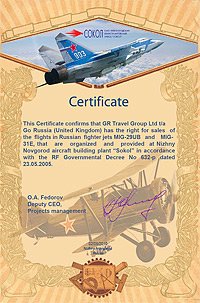 |
 | ||
| +44 (0) 20 33 55 77 17 | Call me back | Chat online | |
No flash player!
It looks like you don't have flash player installed. Click here to go to Macromedia download page.
Speed and G-force - supersonic flights on military fighters MiG in Russia
When preparing for MiG adventure your pilot will describe your flight envelope using various terms from physics, and some of them you will even see on the control devices in the cockpit. We would like to give you some basic explanations before your flight so it will be easier for you to understand:SPEED
Air Forces generally use the term “Mach” to define the speed of the aircraft. Mach number (named after Ernst Mach, Austrian physicist) is the speed of an object divided by the speed of sound (with air temperature 20° C 343 m/s or 1235 km/h or 770 mph). The higher Mach number you see on the control device the higher is the speed of the aircraft.
Jet flights are normally classified in the following categories:
- Subsonic: M < 1
- Transonic: M = 1 (sound barrier)
- Supersonic: 1 < M < 5
- Hypersonic: M > 5
You can calculate your speed at different altitudes using Mach number and compare it to the speed of sound at NASA website,
To read more about Mach and speed of sound please visit http://en.wikipedia.org/wiki/Mach_number
G-FORCE
 When you fly fighter jets you must consider G-forces, or G-load - a numerical ratio of any applied force to the gravitational force at the earth's surface. This is a force that acts on a body as a result of acceleration or gravity and is described in units of acceleration equal to one G. For example, a 10 pound object undergoing a G-force of 5 G experiences 50 pounds of force. The force of gravity on Earth is used as a baseline for measuring these forces of acceleration. As you pull more Gs, your weight increases accordingly.
When you fly fighter jets you must consider G-forces, or G-load - a numerical ratio of any applied force to the gravitational force at the earth's surface. This is a force that acts on a body as a result of acceleration or gravity and is described in units of acceleration equal to one G. For example, a 10 pound object undergoing a G-force of 5 G experiences 50 pounds of force. The force of gravity on Earth is used as a baseline for measuring these forces of acceleration. As you pull more Gs, your weight increases accordingly. The force of gravity when you are still (for example, when you sit, stand or lie down) is considered 1 G. Generally, during our normal activities we rarely experience anything other than 1 G. However sometimes in our everyday life we can experience G-forces stronger than 1 G. For example, a typical cough produces a G-force of 3.5 G, a sneeze results in about 3 G of acceleration. Humans can tolerate localised G forces in the range of 100 G for an instant. However, sustained G forces above 10 G can lead to permanent injury or even death.
When flying MiG aircraft you can experience G forces up to 9 G. Pulling high Gs without any preventive measures can be dangerous (as G forces will push the blood in your body towards your feet and block your heart's attempts to pump it back upwards). You can experience both positive (during such manoeuvres like banking sharply or pulling out of a dive) and negative (during such manoeuvres like pushing the nose of the plane down) G forces. When you experience negative G forces, your blood is pushed up into your head, just the opposite of positive G forces.
All our pilots and customers will wear a special suit, so called “G-suit”. This is a special element of pilots’ kit and generally takes the form of tightly-fitting trousers, which fit either under or over the flying suit, G-suit is connected to the aircraft and using compressed air it automatically pushes the blood back up towards your head during high G manoeuvres. Our experienced personnel will help you put on your G-suit and connect it to the aircraft equipment.
Tailor-made pilot suit: you can order a flight suit made-to-order for your fighter flight displaying your name which you can take back from Russia for your long memories of the flight (please note the pilot suit does not include any protective equipment).
View pilot equipment
